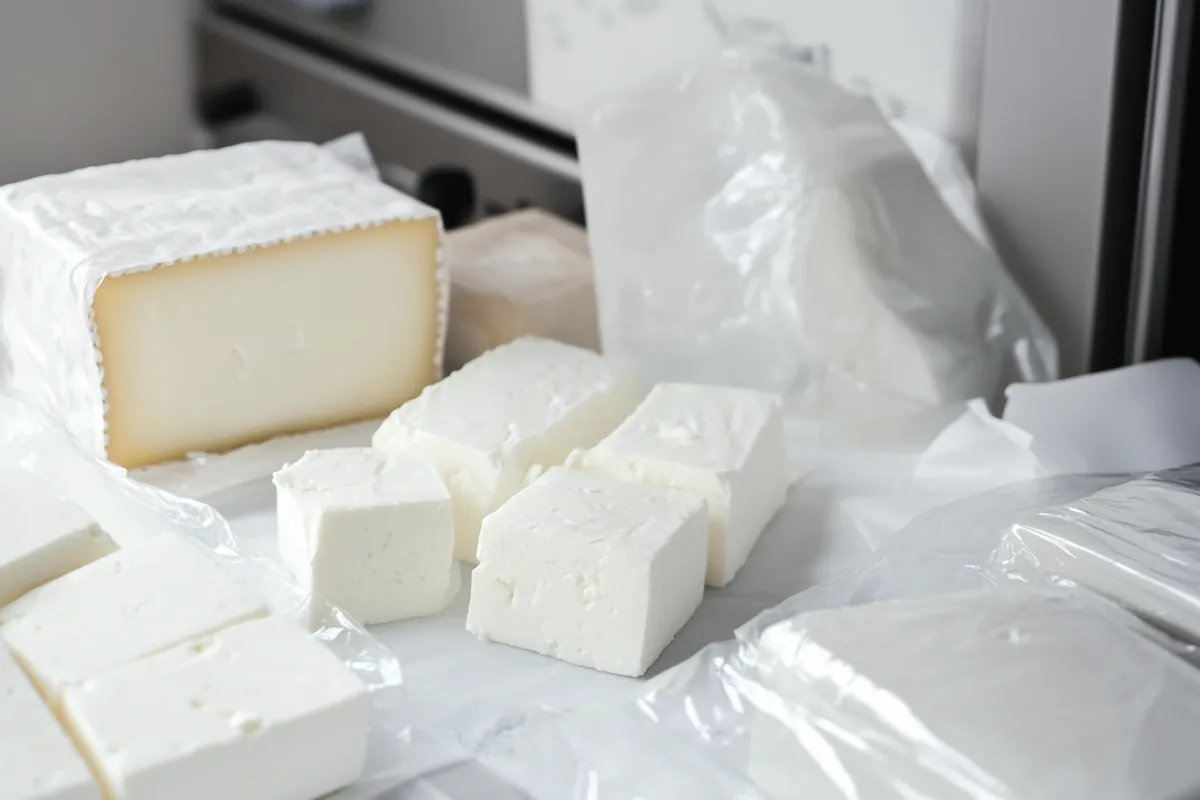Feta cheese is a delicious and versatile ingredient that can elevate many dishes. However, if you buy it in bulk or have leftover feta, you may wonder how to preserve its freshness. This guide will help you freeze feta cheese effectively, ensuring you can enjoy it later without compromising taste or texture.
Table of Contents
Understanding Feta Cheese
Feta cheese is a brined curd cheese that hails from Greece. It has a crumbly texture and a tangy flavor, making it popular in salads, pastries, and various Mediterranean dishes.
What is Feta Cheese?
Feta cheese is traditionally made from sheep’s milk or a blend of sheep and goat’s milk. It is known for its distinct white color and crumbly consistency. The cheese is aged in a brine solution, which gives it a unique flavor profile. You can find feta cheese in various forms, including block, crumbled, and in jars immersed in brine.
Nutritional Benefits of Feta Cheese
Feta cheese is not only tasty but also packed with nutritional benefits. Here are some key points about its health benefits:
- Low in Calories: Feta cheese is lower in calories than many other cheeses, making it a great option for those watching their caloric intake.
- Rich in Nutrients: It contains calcium, phosphorus, and B vitamins, which are essential for bone health and energy production.
- Probiotic Benefits: Feta cheese contains beneficial bacteria that can support gut health.
Can You Freeze Feta Cheese?
Yes, you can freeze feta cheese, but there are some important considerations to keep in mind.
Does Feta Freeze Well?
Feta cheese can be frozen, but the texture may change. When frozen and then thawed, feta cheese can become slightly grainy. However, it still retains its flavor and can be used in cooked dishes like casseroles or pasta.
Factors Affecting Freezing Feta Cheese
Several factors can influence how well feta cheese freezes:
- Moisture Content: Feta cheese with higher moisture content may not freeze as well as drier varieties.
- Form: Block feta tends to freeze better than crumbled feta, as it retains its structure better during the freezing process.
Can You Freeze Crumbled Feta Cheese?
Yes, you can freeze crumbled feta cheese. However, as mentioned earlier, the texture may change, making it less ideal for salads but still suitable for cooking.
Differences Between Block and Crumbled Feta
When freezing, block feta tends to hold its shape better compared to crumbled feta. If you plan to use feta in dishes where texture is less critical—like in baked recipes—either form can work.
How Long Can You Freeze Feta Cheese?
The duration for which you can freeze feta cheese varies.
Recommended Freezing Duration
Generally, feta cheese can be safely frozen for up to three months. Beyond this period, it may still be safe to eat, but the quality may decline.
Best Practices for Freezing Feta Cheese
To optimize the freezing process and preserve the quality of feta cheese, follow these best practices:
- Use Airtight Packaging: Wrap the cheese tightly in plastic wrap or aluminum foil, then place it in an airtight container or a freezer bag.
- Label and Date: Always label and date your packages so you can keep track of how long they’ve been in the freezer.
By following these tips, you’ll ensure that your feta cheese maintains its quality while frozen, ready for use in your favorite recipes.

How to Freeze Feta Cheese Properly
Freezing feta cheese is straightforward, but it requires attention to detail to ensure the best results. Below, we outline a step-by-step guide to help you freeze feta cheese effectively.
Step-by-Step Guide to Freezing Feta Cheese
Choose Your Feta: Start with fresh feta cheese. If it’s already crumbled, consider whether you want to freeze it in that form or in blocks for better texture retention.
Prepare the Cheese: If you have block feta, cut it into smaller portions if desired. This will make it easier to use later.
Wrap the Cheese: Wrap the feta tightly in plastic wrap or aluminum foil. Make sure there are no exposed areas to prevent freezer burn.
Place in an Airtight Container: After wrapping, place the feta in an airtight container or a heavy-duty freezer bag. Squeeze out as much air as possible before sealing.
Label and Date: Use a marker to label the container or bag with the date of freezing. This will help you track how long it has been in the freezer.
Freeze: Place the container in the freezer. Try to keep it in a spot where it won’t get jostled around, as this can affect the texture.
Preparing Feta for Freezing
Before freezing, consider the following tips to prepare feta cheese:
- Brined Feta: If your feta is in brine, you can freeze it in the brine. Just make sure to leave some space in the container for expansion when it freezes.
- Drained Feta: If using feta that isn’t brined, drain any excess moisture before wrapping it. This helps maintain its texture.
Packaging Feta for the Freezer
Choosing the right packaging is crucial. Here are some options:
- Plastic Wrap: Good for wrapping blocks of feta tightly to eliminate air exposure.
- Aluminum Foil: Works well for an additional layer of protection; ideal for blocks as well.
- Freezer Bags: Excellent for crumbled feta. Just ensure to remove as much air as possible.
How to Defrost Feta Cheese Quickly
Once you’ve frozen your feta cheese, you may need to defrost it quickly. Here are some effective methods to do so.
Methods for Quick Defrosting
Cold Water Method: Place the wrapped feta cheese in a bowl of cold water. Change the water every 30 minutes until thawed. This method can take 1-2 hours, depending on the size of the feta block.
Microwave Defrosting Techniques: If you’re in a hurry, you can use the microwave. Place the feta in a microwave-safe dish, cover it loosely, and use the defrost setting in short intervals, checking frequently to avoid cooking it.
Using Cold Water to Defrost Feta Cheese
The cold water method is effective because it keeps the feta at a safe temperature while defrosting. Here’s how to do it:
- Step 1: Fill a bowl with cold water.
- Step 2: Submerge the wrapped feta cheese.
- Step 3: Change the water every 30 minutes until fully thawed.
Microwave Defrosting Techniques
If you choose the microwave method, follow these steps:
Place Feta in a Dish: Use a microwave-safe dish and cover it loosely with a microwave-safe lid or plastic wrap.
Select the Defrost Setting: Use the microwave’s defrost setting, typically around 30% power.
Check Frequently: Stop the microwave every 15-20 seconds to check the cheese. This helps prevent it from starting to cook.
Can You Freeze Feta Pasta?
Yes, you can freeze feta pasta dishes, but there are some tips to keep in mind for best results.
Freezing Feta Pasta Dishes
When freezing pasta with feta, consider the following:
- Cooked Pasta: Make sure the pasta is fully cooled before freezing. This helps maintain texture.
- Sauce and Cheese: If you’re using feta in a sauce, combine it before freezing. This will help maintain its flavor and texture.

Impact of Freezing on Feta Cheese
Freezing feta cheese can extend its shelf life, but it’s essential to understand how the process affects texture and flavor. Here, we’ll dive into the implications of freezing feta and how to best use it afterward.
Does Freezing Feta Change the Texture?
Yes, freezing does alter the texture of feta cheese. When you freeze feta, ice crystals form within the cheese, which can lead to a grainy or crumbly texture once thawed.
Comparison of Fresh vs. Frozen Feta
- Fresh Feta: Retains a creamy, smooth texture, making it ideal for salads and as a topping.
- Frozen Feta: May become more crumbly and less creamy, making it better suited for cooked dishes like casseroles or pasta.
Flavor Changes After Freezing
The flavor of feta cheese generally remains intact after freezing. However, some subtle changes may occur:
- Intensity: The saltiness may become more pronounced after freezing and thawing.
- Freshness: The complex flavors associated with fresh feta might slightly diminish, but it still works well in cooked dishes.
Storing Feta Cheese: Tips and Tricks
Proper storage is crucial to maintain the quality of feta cheese, whether fresh or frozen.
How Long Does Feta Cheese Last in the Refrigerator?
Feta cheese can last about one week in the refrigerator once opened. If it remains in brine, it can last longer—up to two to three weeks. Here are some storage tips:
- Keep it in the Brine: If your feta cheese is in brine, store it in that solution to prolong its freshness.
- Use an Airtight Container: If not in brine, transfer feta to an airtight container to minimize exposure to air and moisture.
Signs of Spoiled Feta Cheese
Knowing when feta cheese has spoiled is essential for food safety. Here are signs to look for:
- Off Smell: If the cheese smells sour or has an unusual odor, it may be spoiled.
- Mold Growth: Visible mold on feta cheese is a clear sign that it should be discarded.
- Texture Changes: If the cheese feels excessively slimy or dry out, it’s time to let it go.
Proper Storage Techniques for Feta Cheese
To maximize the shelf life of feta cheese, consider these storage techniques:
- Refrigeration: Keep feta cheese in the coldest part of the refrigerator, ideally at a temperature below 40°F (4°C).
- Freezing for Long-Term Storage: As mentioned, freeze feta in airtight containers or freezer bags, ensuring it’s well-wrapped to prevent freezer burn.
By understanding how to store feta cheese properly, you can enjoy its flavor and benefits for longer, whether fresh or frozen.

Additional Resources and Recipes
If you’re looking for inspiration on how to use feta cheese in your cooking, consider exploring these additional resources:
Recipes Using Feta Cheese
- Feta and Spinach Stuffed Chicken: A delightful dish that combines the flavors of feta with tender chicken.
- Mediterranean Pasta Salad: This recipe is perfect for summer picnics, featuring feta, olives, and fresh vegetables.
- Feta Cheese Dip: A quick and delicious appetizer that pairs well with crackers or vegetables.
Links to Further Reading on Cheese Storage
For more information on cheese storage and usage, visit our resources on proper cheese handling techniques and creative recipes that use various types of cheese.
Conclusion: Making the Most of Your Feta Cheese
In summary, knowing how to freeze feta cheese effectively can help you enjoy this delicious ingredient without waste. By understanding how freezing affects texture and flavor, you can make informed decisions on using your feta in various dishes.
Recap of Key Points
- Feta cheese can be frozen for up to three months.
- Proper wrapping and packaging are essential to maintain quality.
- Thawed feta cheese is best used in cooked recipes.
Final Thoughts on Freezing Feta Cheese
Freezing feta cheese is a practical solution for those who want to extend its shelf life. With the right techniques, you can enjoy the flavor and nutritional benefits of feta cheese even months later. Whether you’re using it in salads, pasta dishes, or baked recipes, knowing how to freeze and thaw feta properly ensures you get the most out of this versatile cheese.
FAQ
Many people have questions about freezing feta cheese. Here are some of the most common inquiries along with their answers.
Does Feta Freeze Well?
Yes, feta cheese can freeze well, but it may experience some texture changes. While the flavor remains mostly intact, the cheese may become slightly grainy or crumbly after being thawed. For this reason, it is best used in cooked dishes rather than fresh salads.
What Cheeses Should Not Be Frozen?
While many cheeses can be frozen, some do not freeze well. These include:
– Soft Cheeses: Cream cheese and ricotta may become watery and lose their creamy texture when thawed.
– Aged Cheeses: Hard cheeses like Parmesan may become overly crumbly and lose their flavor after freezing.
Tips for Using Frozen Feta Cheese
When using frozen feta cheese, keep the following tips in mind:
– Cooking: Thawed feta works best in cooked dishes, such as casseroles, pasta, or baked goods, where texture is less critical.
– Flavor Adjustment: If the flavor seems too salty after thawing, consider balancing it out with additional ingredients in your recipe.




